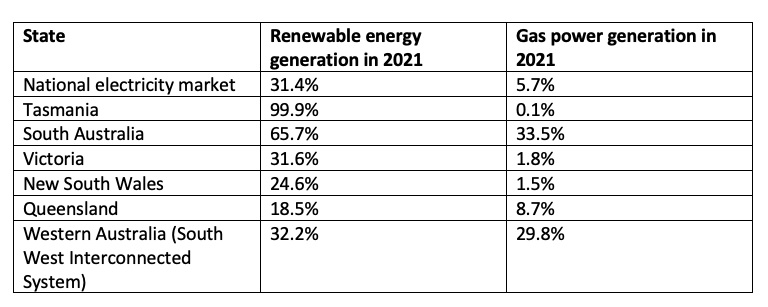ASX Green Energy Stocks: Renewables supplied 5 times more power than gas in 2021, Hazer inks Canadian hydrogen deal

Electricity is now the cheapest it has been in almost a decade, The Climate Council says. Pic: Mohit Bhatia via Getty Images
New data from the Climate Council shows renewables provided five times more power into Australia’s largest grid than gas in 2021.
Figures topped record highs in all mainland states while gas generation fell to its lowest level in more than 15 years in the National Electricity Market (NEM).
The plummet occurred despite no change in electricity demand, the council said.
“The increase in solar, wind and batteries in our electricity system is making power bills cheaper for Australian households and businesses,” Climate Council senior researcher Tim Baxter said.
“Let’s be clear, this record has nothing to do with the federal government, which has been missing in action and leaving all the heavy lifting to the states and territories.
“Electricity is now the cheapest it has been in almost a decade, and we have solar and wind to thank for that.”
Market veering away from gas and towards renewable energy
Renewable energy generation increased by almost 20 per cent in the NEM in 2021, with a 30 per cent jump in Victoria and 26 per cent jump in Western Australia.

In South Australia, gas generation slumped to its lowest level in more than two decades, while in Victoria it dropped a whopping 30 per cent in just 12 months.
In NSW, gas provided just 1.5 per cent of the state’s power, its lowest level in 15 years and Tasmania equalled its previous record of 99.9 per cent of wind, water and sun in 2021.
Climate Councillor, former BP Australasia president, and energy expert Greg Bourne said every taxpayer dollar spent on new gas-fired power infrastructure is at risk of being wasted on unnecessary stranded assets.
“Gas simply cannot compete with renewable energy, which is bringing down power prices for consumers and creating a cleaner, healthier energy system,” he said.
“We’re also seeing a similar clean energy trend on the other side of Australia, in WA’s largest grid, which for the first time ever in 2021 saw renewables overtake gas to become the state’s biggest source of power.
“This is incredibly significant considering renewable energy generation has more than doubled in WA in just three years,” he added.
“Why is the Morrison Government investing in gas-fired power stations when the need for gas in our electricity system is clearly disappearing?”
Hazer signs MOU for Canadian low-carbon hydrogen production project
Clean tech company, Hazer (ASX:HZR), has executed a memorandum of understanding (MoU) with Suncor Energy Inc for the development of a 2,500tpa low carbon emission hydrogen production facility based on its ‘Hazer Technology’.
The project will process natural gas feedstock to produce 2,500tpa low-carbon emission hydrogen and around 900,000 tonnes of synthetic graphite by-product.
Three companies – Hazer, Suncor, and FortisBC, an electricity and natural gas distribution utility in British Columbia, Canada – will collaborate to deliver a feasibility study, funding arrangements, and binding agreements to establish the project consortium.
HZR said Suncor will lead the development of the project through the initial feasibility study, and on completion, will operate the facility while FortisBC is set to supply natural gas feedstock to the project as well as purchase the hydrogen produced from the facility.
Hazer on the other hand will supply the Hazer Process technology, lead engineering relating to the core Hazer technology components, and manage supply of catalyst to the project.
The feasibility stage will kick off this month with the award of an engineering services contract ahead of a final investment decision targeted for 2023 and operations to begin in 2025.
Next generation battery technology patent granted
Leading supplier of high-performing graphene products, First Graphene (ASX:FGR) has secured an additional patent within its existing Hydrodynamic Cavitation patent family, with the United Kingdom Intellectual Property Office.
The patent describes how the Hydrodynamic Cavitation Process Technology can be used to coat particles with a surface coating of graphene platelets.
It is a potential enabling technology for producing graphene coated silicon particles for use as anode materials in energy storage devices.
Hydrogen gas produced as by-product
FGR says the patent covers the use of First Graphene’s cavitation process technology to “directly grow conductive graphene nanoplatelets on to the surface of suitable particles, including silicon.”
“The benefit is that the process is simple, scalable and uses readily available feedstocks that are processed under bulk ambient conditions, as opposed to standard industry practices that require temperatures in excess of 900°C,” the company said.
“Another benefit is that the process is clean – hydrogen gas is produced as a by-product.”
A key challenge in the development of the ‘next generation of batteries’ is how to increase their energy storage capacity.
Where existing carbon anodes typically have an energy density of about 400mAhg-1, the company explains, the equivalent theoretical value for silicon is an order of magnitude higher, at 4200 mAhg-1.
This makes silicon a very attractive material for energy storage devices.
Related Topics
UNLOCK INSIGHTS
Discover the untold stories of emerging ASX stocks.
Daily news and expert analysis, it's free to subscribe.
By proceeding, you confirm you understand that we handle personal information in accordance with our Privacy Policy.








